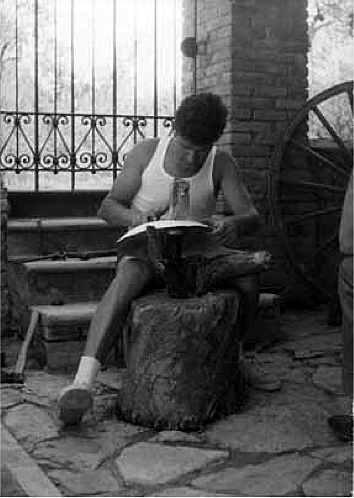On View at the Renwick: Artist Ubaldo Vitali Has Silver in the Blood
/https://tf-cmsv2-smithsonianmag-media.s3.amazonaws.com/filer/20110520110723SAAM_craft_vitali_25th_annv_coffee.jpg)
Ubaldo Vitali (b. 1944) is “arguably the greatest living silversmith in the United States,” according to Ulysses Dietz, one of the curators of the new Renwick Gallery exhibition, History in the Making: Renwick Craft Invitational. Vitali is a go-to-guy for commissioned work from high-end houses like Tiffany, Cartier and Bulgari, as well as for restoration of antique silver pieces. Stylistically, he combines traditional craftsmanship and technique with elements of modern design.
As an artist, Vitali is constantly aware of the ever-changing interplay of light as it bounces off of the surface of his works, or as he puts it, “each object reflects its own structure, its own soul, its own personality.”
Italian-born and trained, Vitali came up in the old-school guild system in Rome, later emigrating to New Jersey in the late 1960s. And he maintains those roots, still a member of a Roman goldsmith’s guild. In fact, he’s the only member allowed to reside outside of Rome.
Vitali’s pieces are featured in the exhibition, along with works by three other artists—ceramic artist Cliff Lee, furniture maker Matthias Pliessnig and glass artist Judith Schaechter—that share his sensibilities regarding updating classical technique with modern style. He'll also be giving an artist talk about his work Sunday, April 17 at 1:30 at the Renwick Gallery.
I caught up with Vitali at the press preview and found him to vaguely resemble an older, more Italiano version of George Clooney in his suit. It was almost difficult to imagine the elegant gentleman in front of me pounding sheets of silver and making the precious metal bend and melt. But initial appearances can be deceiving, and Vitali’s enthusiasm for his craft, as well as his humble nature, shine through when he speaks.
What attracted you to working with silver, as opposed to, say clay, stone, or other metals?
I come from a family of silversmiths. I am the fourth generation. I went to my father and grandfather’s workshops since I was very young. However, all my studies were in the arts, and I was given the freedom to be a painter or a sculptor. But I guess it was in the blood. Silver was in the blood, and it always kept pulling me back.
You were trained in the old world-style guild system of silversmiths. Briefly, what is that like, and how long does it take to go from being an apprentice to a master?
The guild system is more a symbolic thing. In the past, the role of the guild, besides controlling the metal, was to be insurance for the family. If you died young they would take care of your widow and the children. It was a system of support. Today we don’t need that anymore, so it’s basically symbolic. As far as apprenticeship is concerned, by the 20th century, you don’t have to be an apprentice in order to become a master, at least in my field. But most of the people that start in this business are young, usually ten or eleven . They go maybe two, three hours a day, like in internships here. Then if you feel you have some kind of attraction to it, these people will become more and more involved.
Do you think traditional silversmithing has become a lost art?
Yes and no. Actually, it’s practiced more in the U.S. than the rest of the world, because you have so many colleges that offer courses. However, whenever you make something institutionalized, it loses a lot…When people come out of an institution, even if they have a Master’s, they will end up teaching, because it’s very difficult for a silversmith to establish an economically viable business. It’s almost impossible.
Do you think technology has helped or hindered the process of silversmithing?
In my shop, I use the oldest techniques…But on the same token, I have the latest technology, from hydrogen flames to induction melting, all kinds of microscopy. You name it, we have it. There is no reason to shut the door to technology–You embrace it.
History in the Making: Renwick Craft Invitation 2011 is on view at the Smithsonian American Art Museum's Renwick Gallery, located at Pennsylvania Avenue at 17th Street N.W., through July 31. The show was curated by Nicholas R. Bell. The artists were selected by Bell, Ulysses Dietz, senior curator and curator of decorative arts at The Newark Museum and Andrew Wagner, editor-in-chief of ReadyMade Magazine.
This post was updated to clarify the role of the visiting scholars.
/https://tf-cmsv2-smithsonianmag-media.s3.amazonaws.com/accounts/headshot/Jeff-Campagna-240.jpg)

/https://tf-cmsv2-smithsonianmag-media.s3.amazonaws.com/accounts/headshot/Jeff-Campagna-240.jpg)